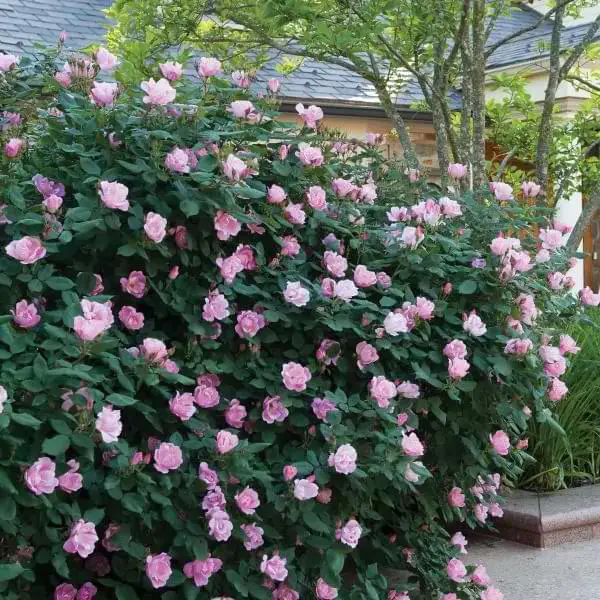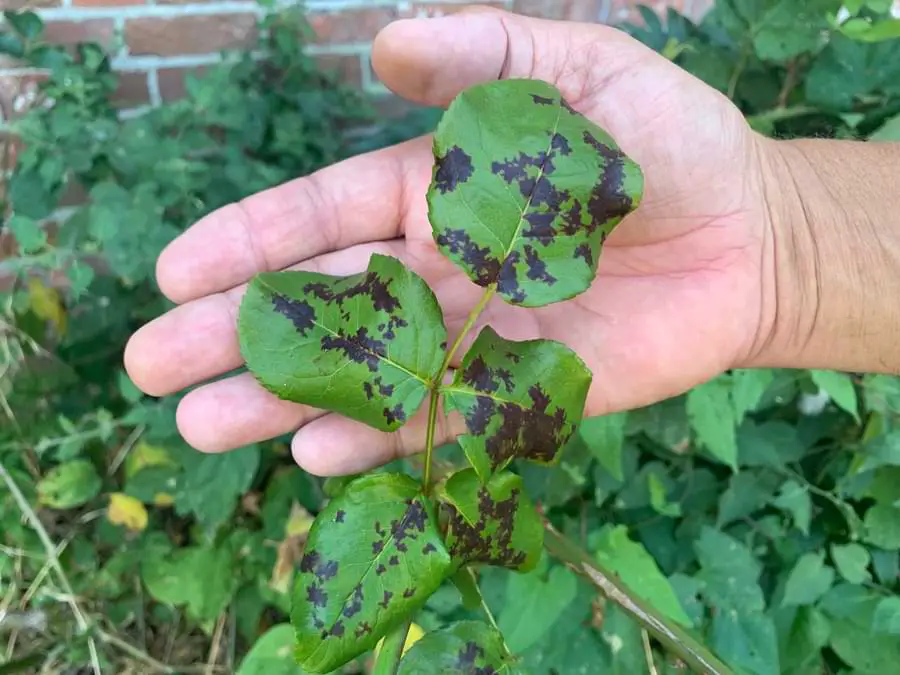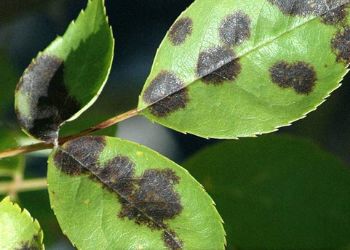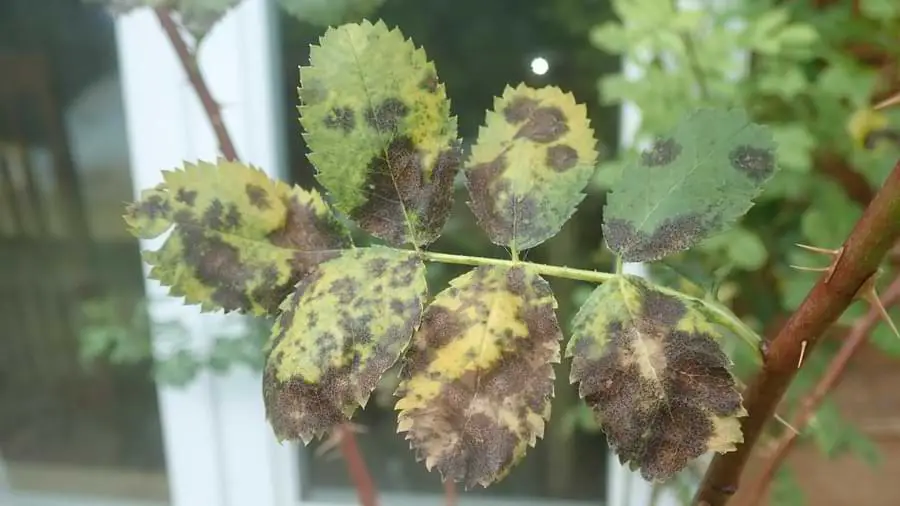I assume you arrived here because you’re concerned you might have black spot disease on roses in your garden?
If so, then my heart goes out to you. Any gardener who grows roses will tell you that one concern is black spot disease on roses. So in this post, I’m going over what black spot disease on roses is, the treatments, and ways you can prevent it.
Black spot is a harmful fungal disease that can affect roses. It is officially called Diplocarpon rosae and infects the leaves of a rose, effectively draining the energy out of them. You can expect to start seeing black spot disease on roses in spring and it can last a couple of seasons.
Black spot fungus disease is genetically diverse and new strains appear frequently. Sadly, this means the resistance developed into new cultivars typically fails to endure because new fungal strains emerge to overcome it.
But how will you know if your roses have black spot disease? Read on to find out more.
Signs of black spot disease on roses
What exactly should you be noticing then if your roses are suffering from black spot disease?
Initially, symptoms begin as a feather-edged appearance of black spots around the lower leaves. The spots will enlarge and the leaves will turn yellow and drop off. The disease will progress up the rose canes and stems until the entire plant is infected and becomes defoliated
With black spot disease on roses, you will notice a quickly expanding purplish or black patch with scattered and radiating strands of the fungus on the upper leaf surface. Other parts of the rose may remain unaffected initially at least. Affected leaves will likely fall away, and the area around the spots will turn yellow.
Infected leaves will continue to fall despite the absence of the yellow color in some cases.
For relatively small spots, the leaf may not fall. But small, black, scabby lesions may appear on developing stems. Roses with severe damage can lose practically all of their leaves, and they lose all their energy in the fight to regain their growth.
These symptoms are so common that the disease has reportedly been held accountable for a recent drop in the popularity of roses in UK gardens.

What causes roses to develop black spot disease?
Black spots and roses, sadly, go hand in hand. Many roses get a minor black spot that the plants can even endure to some extent. Heavy infections, however, can severely defoliate plants.
On the upper leaves, dark brown to black leaf spots appear before the leaves turn yellow and fall off.
The intense black color and fringed margins of black spot disease set it apart from other leaf spot diseases. On rose canes, raised, reddish-purple dots can also be seen. Its germination and growth are favored by warm, humid circumstances.
How black spot disease on roses transfers
As black spot disease consists of tiny spores, primarily, the wind is responsible for transporting and transmission from leaf to leaf and plant to plant, although moisture is also necessary for it to germinate.
Prolonged periods of damp and humid weather are excellent breeding grounds for black spot disease to establish itself and spread widely.
Which roses are more prone to black spot?
Black spot can affect all categories of roses. But some cultivars are significantly more prone than others. And this boils down to how generally disease-resistant the rose variety is.

Floribundas, shrub roses, and climbing roses are the most disease-resistant rose varieties, while hybrid tea roses, grandifloras, and miniature roses are the least disease-resistant.
In general, roses with an open, breezy canopy are less likely to be infected, compared to rose bushes with dense foliage or leaves that grow close to the ground.
By planting the newest varieties that promise greater resilience, rose gardeners may experience a little respite, but as previously mentioned, this may just serve to reduce the chances. However, there is little impact on older species.
Which roses are black spot resistant?
Unless you are a mass rose producer who constantly monitors their rose stock, you may be unlikely to notice blackspot until it’s in its adult stage.
According to studies, some rose genera are less susceptible than others. So the easiest way to get rid of black spot disease in your rose bed is to swap out your most susceptible roses with more modern, disease-resistant roses.
Additionally, disease-resistant roses are less prone to other typical fungal diseases such as powdery mildew, rust, and anthracnose.

Knock Out® Roses are very popular for this very reason.
So something like the Blushing Knock Out Rose is considered to be very disease resistant.
The level of resistance varies with plant care, soil conditions, and the surrounding environment, but in most cases, your disease-resistant roses won’t suffer much even if they do get black spots.
Some resistant types of roses tend to get some black spot on their leaves and yet won’t defoliate. The plant’s genetics are strong enough to preserve the leaves on the plant even in the presence of this disease.
Preventing black spot disease on roses
Keeping rose bushes in plenty of space is the first step. Places with full sunlight and sufficient airflow are ideal planting areas. Along with pruning, using resistant cultivars, and providing suitable planting places that avoid damp shade are all part of preventing black spot rose disease.
To treat black spot on roses, maintain a clean garden, and overhead watering needs to be avoided during the growing season
It’s also crucial to remove leaf litter. When pruning and deadheading, keeping the rose bushes thinned will improve airflow through the bushes, assisting in the protection against black spots on roses and other fungal diseases.
Treatment for black spot should begin as soon as you start noticing the spots. Good cultivation practices such as gardening hygiene and introducing natural enemies act as a defense against pests, diseases, and weeds.
Black spot disease – Remedies
You can use Green Cure as a primary fungicidal spraying solution as it is environmentally safe and effective.
You can also use neem oil, which also works to treat a lot of pests that affect roses, it works particularly well against spider mites.
Baking soda is another product that some people use to alter the pH of leaf surfaces and prevent the spread of black spots on plants. Mix a few tablespoons (29.5 mL) of baking soda with a gallon (4 L) of water to create this organic solution.
A few drops of dish soap without bleach will aid in keeping the baking soda on the leaf. Spray the foliage from both sides. Apply again each week and each time it rains.
Chemical-free remedies
During fall, gather and burn any fallen leaves, or bury them under mulch.
Before the leaves grow again in the spring remove any stem lesions. These measures will delay the beginning of black spot disease, but their effectiveness is rather limited because spores will potentially arrive on the wind from other nearby places.

As you can see from the image above, even my roses suffer from this occasionally. And as much as I look after them I’m not immune. I find my roses can tolerate a certain amount of this, but it’s important to get it sorted out as soon as you see it.
If it gets too out of hand, then you might want to consider more drastic measures like chemical remedies.
Chemical remedies for black spot
Tebuconazole, tebuconazole with trifloxystrobin, and triticonazole are fungicides with labels for the treatment of black spots.
Tebuconazole is available under the brand names Provanto Fungus Fighter Concentrate, Provanto Fungus Fighter Plus, and Toprose Fungus Control & Protect.
Some products, like myclobutanil, contain cypermethrin (Resolva Rose 3 in 1, Rose Shield Bug & Fungus Killer, Roseclear Ultra Gun 2, Rosegarde). As well as triticonazole containing acetamiprid, contains a combination of both insecticide and fungicide, enabling the control of both insect pests and disease.
As I’ve said before, these things will likely happen at some point. It’s how you deal with it that matters.
Black spot disease on roses ~ More roses help 🌹
I hope this has helped to understand what causes black spot disease, and other information. As well as some tools and tricks to help you get rid of it.
Don’t let it put you off growing roses! You’ll find some of these remedies again on my tools and resources page.
Good luck!

Hi, I’m Michael. My passion for roses was sparked a few years ago after visiting a dedicated community rose garden. So Rosehow.com represents my take, my learnings, and my help for anyone looking to grow, be proud of, and harvest roses.


